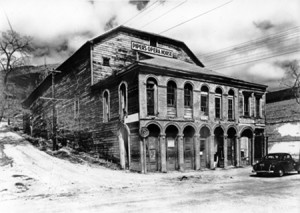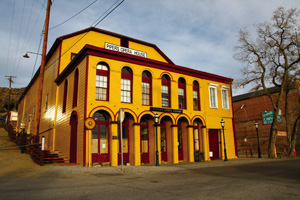From the Ashes
From the Ashes
Newly renovated Piper’s Opera House has been reborn more than once through the years.
BY CHIC DIFRANCIA | JANUARY/FEBRUARY 2009

Virginia City’s Piper’s Opera House has stood as a monument to Comstock entertainment for almost 150 years. Even after withstanding two disastrous fires and suffering through financially tough times when the Virginia City mines ceased operation more than a century ago, Piper’s has managed a successful transition into the 21st century—but it hasn’t been easy.
Piper’s Opera House began as Maguire’s Opera House in 1863, when San Francisco theater impresario Thomas Maguire built the establishment on D Street between Union and Taylor. Maguire did well for a couple years, booking top talent from around the country. He was the first to book Adah Isaacs Menken, who had the starring role in “Mazeppa.” Menken, scantly dressed in flesh-colored tights and a filmy blouse and strapped to the back of a black horse dashing across the stage, caused quite a stir in Virginia City. Mark Twain, who developed a semi-serious relationship with Menken, wrote a review for the Territorial Enterprise based on an earlier “Mazeppa” performance he had seen in San Francisco.
Maguire fell on hard times in 1866-67 and began selling the opera house to John Piper in installments. In March 1867, Piper paid Maguire $2,500 and took over sole ownership of the establishment. Piper came to Virginia City with the first rush of prospectors in 1860. However, he didn’t earn his pay with pick and shovel but with a whiskey bottle. An 1861 lithograph by Grafton Brown shows he owned Old Corner Wines, Liquors, & Co. at B and Union streets. The saloon was a bit joint, meaning one could get two drinks for two bits (a 25-cent value). Piper became entrenched in Storey County politics and was well respected in Virginia City, even before his involvement with the opera house. He was elected to the city council in 1865 and took over as mayor the following year. He served as Storey County commissioner and state senator from Storey County in the Nevada State Legislature in 1875 and 1877.
Piper’s political contributions to Virginia City are all but forgotten today, overshadowed by his three decades of ownership of the famed opera house. Piper gave Virginia City the best entertainment money could buy. Theatrical greats such as Maude Adams, Lotta Crabtree, Lily Langtry, Edwin Booth, and W.F. Cody (Buffalo Bill) all performed at Piper’s. Piper often promised more money than he could afford for top talent. In these cases his millionaire friend, big bonanza king John Mackay, would fill the financial void. Mackay never shared in the profits at Piper’s, but he did hold a proscenium box seat.
Storey County’s population reached 22,000 in 1875. The mines were in full production, and the economy was booming. Piper had been in business for 8 1/2 years and was doing well when disaster struck. On the morning of October 26, a fire broke out at Crazy Kate’s lodge and by evening, 33 blocks of Virginia City were in smoking ruins. The fire destroyed more than 1,000 homes and several hundred commercial buildings, including Piper’s Opera House. Though down, Piper was not out, and he continued to put on shows at the Odd Fellows Hall, National Guard Hall, and other facilities until he raised enough money to construct a new building.

Piper built the second opera house at the rear of his saloon at the corner of B and Union streets. The building was under construction for more than two years and opened on January 28, 1878. During the next five years, Piper presented a variety of entertainment from Shakespeare to burlesque acts. On March 13, 1883, Piper’s Opera House again went down in flames, this time in an early morning fire. A Delta Saloon employee noticed the flames and awakened Piper, who was living in an apartment at the opera house. An alarm sounded, but by the time firemen arrived, the opera house was fully engulfed. Firemen managed to save the surrounding buildings, but the opera house was lost. The origin of the fire was never proven, but suspicion pointed to an unattended cigar. Piper was not only out of business, but homeless.
Through the aid of a generous community, Piper got back on his feet and built a third opera house with lumber from some of the older mine buildings and whatever other materials he could acquire. This is the building—opened with a grand ball on March 6, 1885—that stands today at B and Union streets. The stage is 32 feet deep and 50 feet wide and raked—slanted downward from the rear to afford better viewing for the audience. It was lighted by gas until 1900 when Virginia City was wired for electricity.
Piper died in San Francisco on January 1, 1897 at age 63. Ownership of the opera house went to his son, Edward, who ran it until his death in 1907. Edward’s brother-in-law, Louis Zimmer, took over operations. Under Zimmer, silent movies were shown in the early part of the 20th century. The building was also used for basketball games, roller-skating, dances, graduation parties, and a host of other civic events. The opera house fell into a state of disrepair and was condemned in 1920. Zimmer reopened it as a museum in the 1940s and oversaw it until his death in 1960. Louise Zimmer Driggs, the great-granddaughter of John Piper, took over the opera house and began summer concerts there in 1972.
In 1986, Driggs’ daughter, Carol Piper Marshall, was named managing director and began staging plays. Also in the 1980s, Piper’s hosted performances by Tennessee Ernie Ford, The Mountain Men Ballet, and Hal Holbrook as Mark Twain that played to sold-out audiences.
In 1997, Driggs sold Piper’s to a nonprofit foundation, Piper’s Opera House Historic Programs. The foundation, through the support of the Commission for Cultural Affairs, has used nearly $2.5 million to restore the grand old building. Recent upgrades include a structurally reinforced front façade, a new roof and heating system, and renovated bathrooms and kitchen facilities. Current events include concerts, theater, and dance performances. This spring, to celebrate Virginia City’s sesquicentennial, you should be able to order a drink at the original bar that served Piper’s, closed since the 1883 fire.
Virginia City Celebrates Sesquicentennial in 2009
Virginia City celebrates its 150th birthday June 5-7. Many of the events scheduled are free to the public. Costumed characters participating in Civil War reenactments and a Mountain Man Rendezvous will greet visitors. An Old West gun show, pastry cook-off, and a rock-drilling competition are also on tap. The Fourth Ward School, St. Mary’s Hospital, and the Silver Terrace Cemetery also have special activities scheduled. Food vendors will be scattered throughout town, and a parade with marching band will kick off the event. Parking and in-town shuttles will be free.
Click here to subscribe to Nevada Magazine.
CONTACTS
Piper’s Opera House
12 N. B St., Virginia City
775-847-0433
pipersoperahouse.net
Virginia City Convention & Tourism Authority
86 S. C St., Virginia City
visitvirginiacitynv.com
800-718-7587
WORTH A READ
More Than a Song and Dance: The Heyday of Piper’s Opera House
By Patty Cafferata
Eastern Slope Publisher

